Sample
This report basis its findings on the school health survey as opposed to the researcher reporting findings of original research. The school health survey uses a scientific sample selection process to recruit participants. A scientific sample means that the data collected is representative of the population from which the sample is drawn. The school health survey uses a school-based methodology whereby it selects institutions that meet certain criteria.
Thus, the survey uses probability sampling in which every school that meets the specified criteria has an equal chance of all its learners being recruited to participate in the study. For the purpose of this study, the researcher relied on a sample size of 15,970 participants aged between 13-17 years. This is only a fraction of the school health survey that has recruited more than 450,000 students.
The present study’s sample comprises both male and female participants from different institutions and nationalities. The sample is large enough to enhance research validity and generalization of findings to the entire population of students aged between 13-17 years.
Design
Generally, the research could rely on either positivism or the interpretivism research philosophy. For this study, positivism research philosophy was adopted in several ways. First, the researchers were interested in measuring the students’ experiences based on pre-defined straits such as washing hands after using a toilet or latrine. These traits represent measured and observed knowledge, which are key constituents of the positivism research philosophy.
The opinions of the respondents remained unaltered, or “as it is”, during data analysis. This means that the research-based its findings on statistical outcomes as opposed to the researcher injecting self-interpretation of the respondent’s opinions. The result of this was high levels of research objectivism, which is a key component of positivism philosophy. Alongside the positivist philosophy, the research adopted the survey strategy that involved the use of self-administered questionnaires to collect from the participants. The advantage of using a survey is the fact that they are appropriate when a researcher wished to collect large volumes of data from many participants. This study involved 15,970 participants and hence the use of surveys was justified.
Data Collection
The data collection involved the use of self-administered questionnaires. The requirement was that each respondent completed the questionnaire on his/her own without the intervention of the researcher that would otherwise result in subjectivism in research. Considering the logistics and geographical factors required to meet 15,970 participants, the school health survey had trained representatives from more than 120 countries to facilitate this process.
The survey required them to administer the questionnaires during single regular class periods. This was important because it discouraged the participants from exchanging opinions that would have otherwise affected the accuracy of the results, and hence the research validity and reliability. Since the survey had collected data at particular points in time, which is during single regular class periods, it means that data collection was cross-sectional as opposed to longitudinal.
Data Analysis
The researcher analyzed the data quantitatively instead of qualitatively. Quantitative analysis involves statistical manipulation of data to come up with accurate causal inferences relating to the research variables. On the other hand, qualitative analysis requires the researcher to use long narrations or stories about the research phenomenon. Because of this limitation, the researcher relied solely on the quantitative method and analyzed the data using the SPSS software.
The study used both univariate and bivariate analysis methods. Univariate methods involve analysis of a single variable while bivariate requires two variables to investigate the correlation or association between them. The univariate strategies used included pie charts, bar graphs, and frequency distribution tables. On the other hand, bivariate strategies comprised the one-sample t-tests and chi-square measures of association.
Findings
Univariate Analysis
Frequency of Eating Vegetables
The researcher asked the participants to rate how many times per day they took vegetables based on the average of the past month. About 7,500 or approximately 43% of the participants either reported taking vegetables less than once per day or did not take vegetables at all. Another 8,500 or about 48% reported taking vegetables between 1 to 3 times a day. Finally, about 1,500 students reported taking vegetables 4 to 5 times, which represents about 9% of the total number of students.
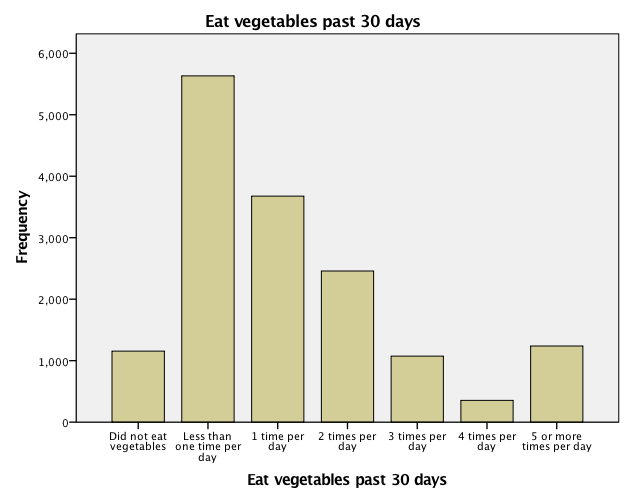
Fights
The respondents were asked to rate the number of times they had engaged in physical fights in the past 12 months. The results turned out that almost 9,000 participants never had a fight in the past 12 months. This represented close to 55% of the total number of students. About 3,000 participants reported a single fight for a period of 12 months, which is about 17% of the total number of students. About 2,000 participants reported 2 or 3 fights whereas about 1,000 participants had 4 or 5 fights, which combined represent another 17% of the total number of students. Only small numbers of students had 6 to 11 fights, although about one 1,000 students, or approximately 5% reported more than 12 fights in a year, which is abnormal.
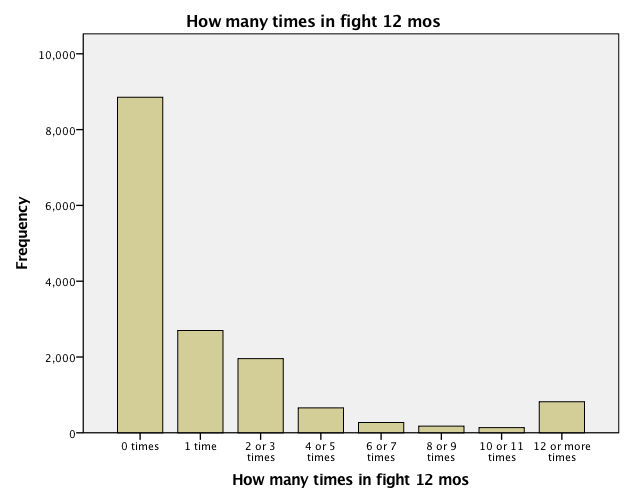
Washing Hands after Toilet
The respondents were asked to rate how often they washed their hands after using the washrooms in the last 30 days. The largest portion of students, approximately 80%, reported washing their hands always after using a latrine or toilet. A good portion of about 10 reported they wash their hands most of the time. However, on the extreme end, a group of approximately 10% of the students washes their hands sometimes, rarely, or they never do so after using a toilet or latrine.
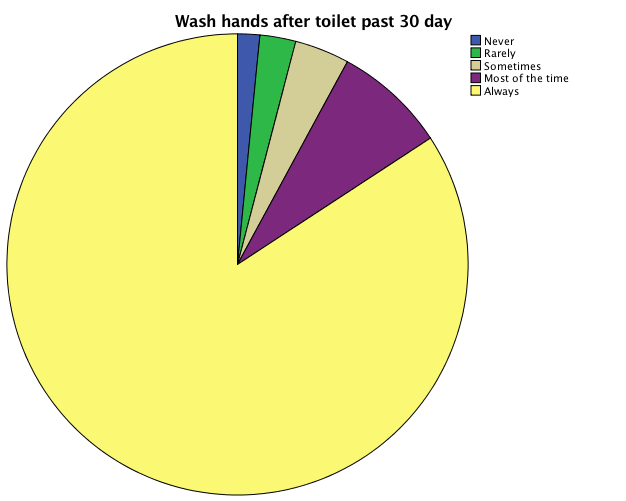
Bullying Cases
The research gathered student’s responses concerning the number of days they were bullied in the past 30 days. The findings indicated that a huge portion of students, approximately 70%, did not encounter bullying at all. A small portion of approximately 15% reported that they encountered bullying in about 2 or 3 days only. However, small portions accumulating to about 15% reported bullying for more than 3 days during that month.
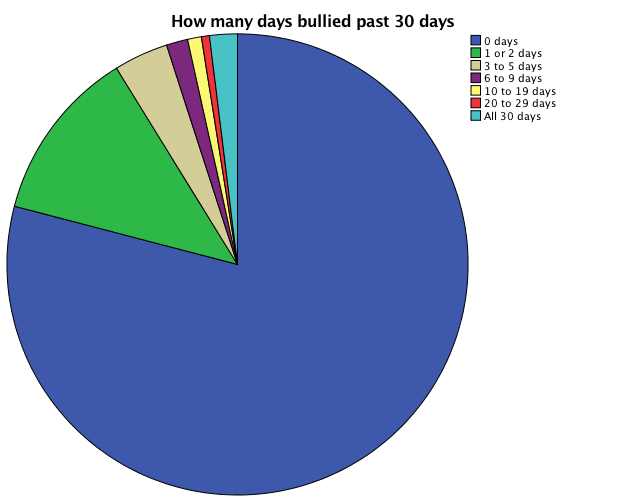
Feeling Sad and Hopeless
The respondents were asked to rate if they had experienced a feeling of sadness and hopelessness for at least a period of two weeks on a daily basis during the past 12 months. Out of the 15,149 participants who answered this question, 5,287 answered “yes’ and 9,862 answered ‘no’. These represented 33.5% and 62.5% respectively, meaning that approximately one-third of students across the various schools experienced sadness and hopelessness for different reasons.
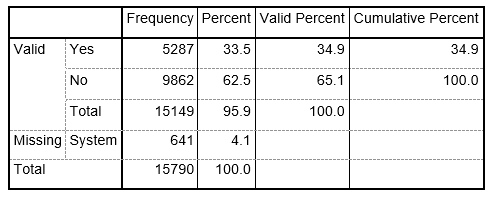
Bivariate Analysis
Relationship between Gender and Washing Hands
Gender and frequency of washing hands after using the toilet in the past 30 days were cross-tabulated. The finding revealed that there were many males than females in the categories of students who never, rarely, or wash hands only sometimes. However, many females than males reported washing hands either most of the time or always after using a toilet.

Further analysis was performed using a chi-square test of independence to examine whether gender and washing hands after using the toilet were related. The findings revealed that the relationship between these two variables was significant, X2 (2, N= 15437) = 42.492, p <.01. Male students were less likely to wash hands after using a toilet in the past 30 days.
Relationship between Gender and Fighting
Gender and number of fights in the past 12 months were cross-tabulated. The finding revealed that there were many men than females in fights between 1 to 12 times. Additionally, many females than males did not have any fight in the past 12 months.

Further analysis was performed using the chi-square test of independence to examine whether gender and number of fights in the past 12 months were related. The findings revealed that the relationship between these two variables was significant, X2 (2, N= 15433) =1210.649, p <.01. Female students were less likely to engage in fights in the past 12 months.
Relationship between Gender and Eating Fruits
Gender and Eating fruits in the past 30 days were cross-tabulated. The finding revealed that there many females than males in most of the categories of people who ate fewer fruits and many males than females in categories of those who ate many fruits per day.

Further analysis was performed using the chi-square test of independence to examine whether gender and eating fruits in the past 30 days were related. The findings revealed that the relationship between these two variables was significant, X2 (2, N= 15482) = 60.201, p <.01. Female students were less likely to eat fruits in the past 30 days.
Relationship between Gender and Lacking Sleep
Gender and lack of sleep in the past 12 months were cross-tabulated. The findings revealed that many males than females either never or rarely could not sleep in the past 12 months. On the other hand, many females than males, either always or most of the time, could not sleep in the past 12 months.

Further analysis was performed using the chi-square test of independence to examine whether gender and lack of sleep in the past 12 months were related. The findings revealed that the relationship between these two variables was significant, X2 (2, N= 15466) = 395.766, p <.01. Female students were less likely to find sleep in the past 12 months than did their male counterparts.
Sex and Number of Close Friend
A one-sample t-test was used to find the association between sex and the number of friends reported by the participants. First, there were more females than males in the sample. This finding is deduced from the fact that the mean obtained for sex was 1.5, which is close to the ‘female’ category in the questionnaire list. The mean obtained for the number of close friends was 3.4, which is close to the ‘3 or more’ category in the question list. This means that majority of participants had more than 3 close friends at school.

Using the sample t-test, the study established that sex (M= 1.5, SD = 0.500) was dominated by more females than males. This can be deduced from the fact that the mean obtained was significantly from the test value = zero, T (15633) = 376.329, p =.000 at a 95% confidence level. Additionally, the analysis established that number of close friends the majority of students have (M= 3.4, SD = 0.936) is three friends on average, as opposed to students who reported zero friends, T (15350) = 449.610, p =.000 at 95% confidence level.

Conclusion
Implications for Policy
There is a need to strengthen policies that support school-family relationships in matters relating to learners’ hygiene and nutrition. Governments and stakeholders should consider implementing a policy whereby all-day schools provide lunch to the students. The advantage of a lunch program is that the school can ensure a balanced diet for the students. This can help improve the number of students who take vegetables and fruits at least once a day. The government can cater to this budget or it can be shared between the parents and the government.
Policymakers should institute policies governing the architectural designs of middle-school constructions. For instance, toilets and latrines should have sufficient plumbing and supply of water in order to encourage students to wash their hands every time they use them. This is evident from the research finding that about 20% of students, a majority of them male, do not wash hands every time they use a toilet or a latrine.
Implications for Practice
There is an urgent need for school heads and principals to find multiple ways of dealing with fights and bullying among middle school learners. This owes to the fact that almost 45% of students are involved in physical fights at least once in a year, in which case the male students are affected the most. School principals should establish communication channels with parents where they can report instances such as lack of sleep, which can help troubleshoot whether a student is troubled by bullying and physical assaults by colleagues at school.
At the school level, principals and stakeholders can intervene in the occurrences of bullying and physical fights among learners by instituting mechanisms that students can use to report threats before they deteriorate into physical fights. This research established that students, both males, and females, have at least three close friends at school. With this knowledge, principals and educators can leverage such friendship ties to encourage learners and pupils to report cases of bullying and fighting threats propagated to their friends.